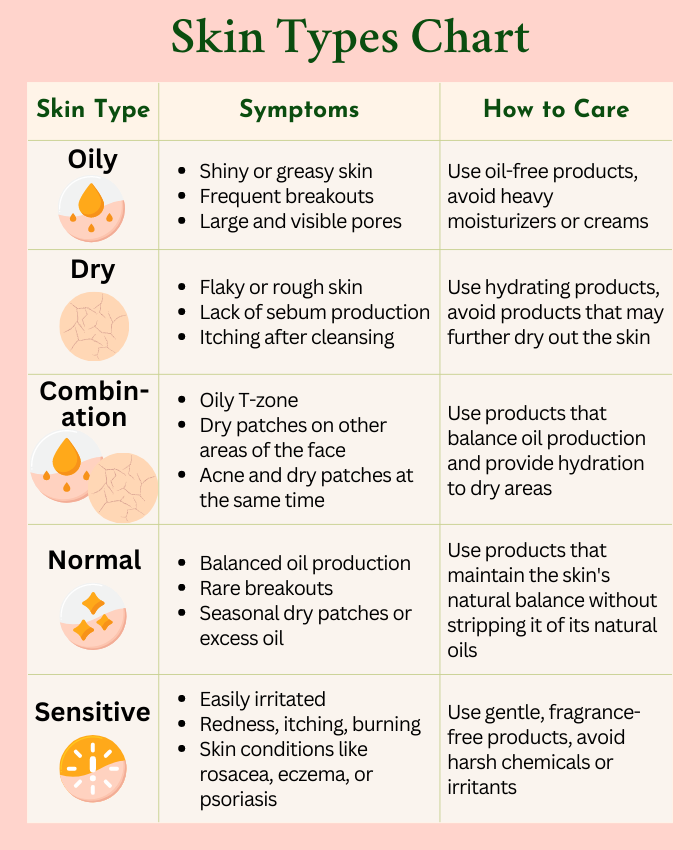Introduction
The first step to achieving healthy, glowing skin is to determine your skin type. Once you know your skin type, you can select the right products and develop a customized skincare routine that addresses your specific needs. In this article, we'll cover how to use a skin type chart to determine your skin type and provide recommendations for products and care based on your skin type.
Knowing your skin type is the first step to having healthy, radiant skin. This information can help you choose the best products and create a skincare regimen that is tailored to your individual needs. We'll go through how to utilize a skin type chart to figure out what sort of skin you have, along with suggestions for products and skin-care regimens depending on your skin type.
Skin Type Chart
A skin type chart can be a helpful tool to help you determine your skin type quickly and easily. We've made one for you here for easy access. See below the image for more details.

- Oily skin – Skin that is shiny or greasy, particularly in the T-zone area. People with oily skin experience frequent breakouts and can have large, visible pores. To care for oily skin, it's best to use oil-free products and avoid heavy moisturizers or creams that can clog pores.
- Dry skin – Skin that is flaky or rough and has a lack of sebum production throughout the day. Those with dry skin experience tightness or itching after cleansing, and their skin is rarely oily. To care for dry skin, it's important to use hydrating products that lock in moisture. It's also good to avoid products that further dry out the skin.
- Combination skin – Skin that is a mix of both oily and dry skin types, with an oily T-zone and dry patches on other areas of the face. Those with combination skin may experience acne and dry patches simultaneously. To care for combination skin, it's best to use products that balance oil production and provide hydration to dry areas.
- Normal skin – Skin that has balanced oil production and rare breakouts. People with normal skin types may experience dry patches or excess oil only seasonally. To care for normal skin, it's best to use products that maintain the skin's natural balance without stripping it of its natural oils.
- Sensitive skin – Skin that is easily irritated and may experience itching, redness, or burning after using certain products. People with sensitive skin may also have skin conditions like eczema, rosacea, or psoriasis. To care for sensitive skin, it's best to use gentle, fragrance-free products and avoid harsh chemicals.
Building a Skincare Routine Based on Your Skin Type
Once you've determined your skin type, you can start building a skincare routine that works for you. Here are some basic steps to follow:
- Cleanser – Choose a gentle cleanser that's appropriate for your skin type.
- Toner – Use a toner to balance the skin's pH and prepare it for moisturizer.
- Moisturizer – Choose a moisturizer that's appropriate for your skin type and provides hydration without clogging pores.
- Sunscreen – Protect your skin from the sun's UV rays with a broad-spectrum sunscreen.
- Treatments – Add treatments to target specific skin concerns, such as hyperpigmentation and/or acne.
It's crucial to remember that each individual has a different type of skin, so what works for one person might not work for another. It's okay to try out various products and techniques until you find what works best for you.


